The Intel Core i7-12700K is a good choice for those looking for a mid-to-high tier CPU with a performance boost over the Core i5-12600K. The Core i7-12700K features the ability to overclock and with the new architectural design from the Alder Lake series, users can expect maximum performance. Combined with parts sent to us from XPG, we were able to build out a solid system for any type of use case that users can think of.
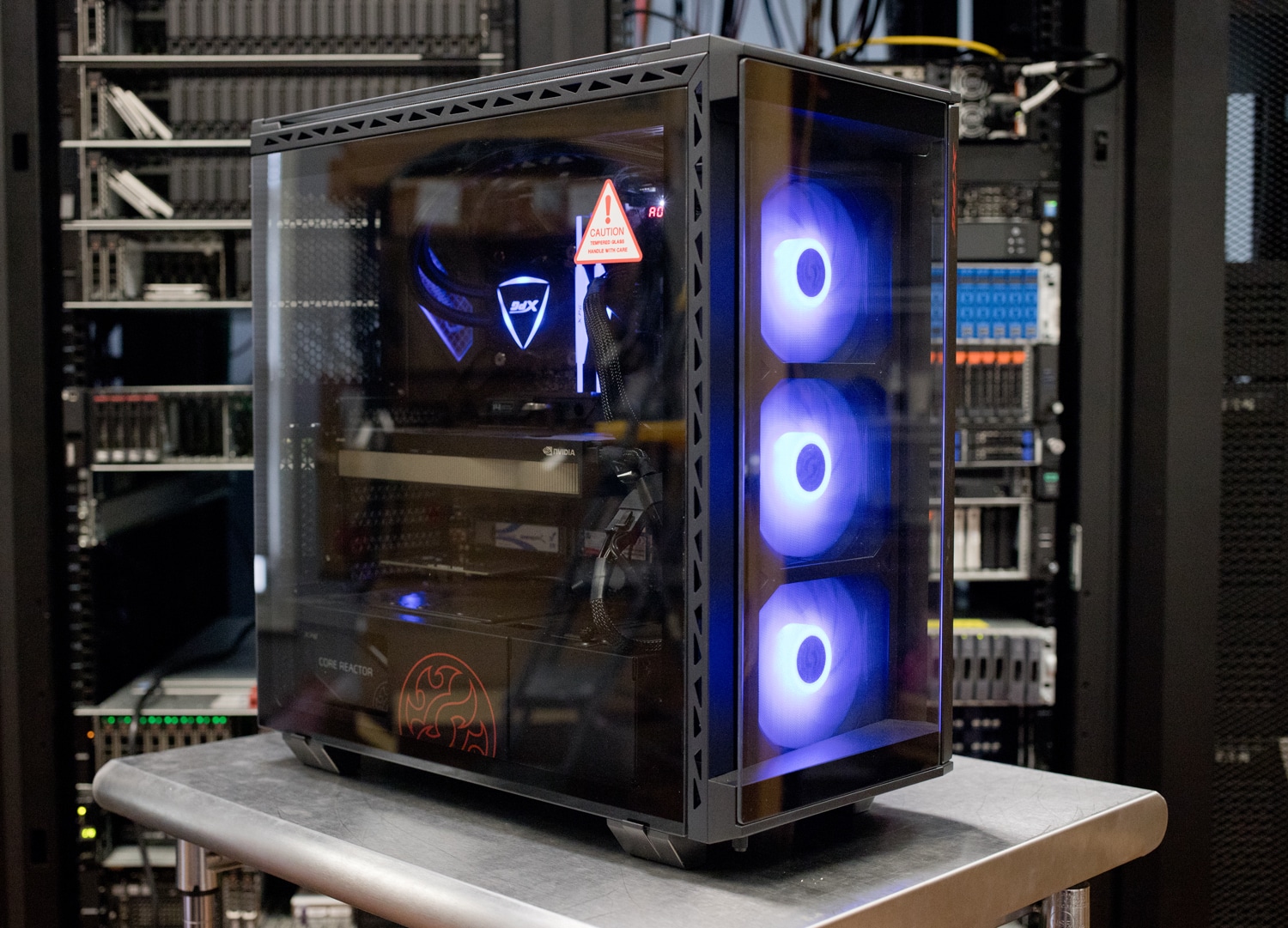
Intel Core i7-12700K XPG Build
For those who aren’t entirely familiar with XPG and who they are, XPG is a PC component offshoot from ADATA. ADATA makes a wide variety of computer technology ranging from SD cards to lightbulbs. Through XPG, ADATA is able to market products to the gaming industry to show off new innovations and products. XPG was kind enough to send us a variety of parts for this review including a case, AIO, RAM, and a power supply. With these parts, we were able to build a decent system leveraging the Intel Core i7-12600K.
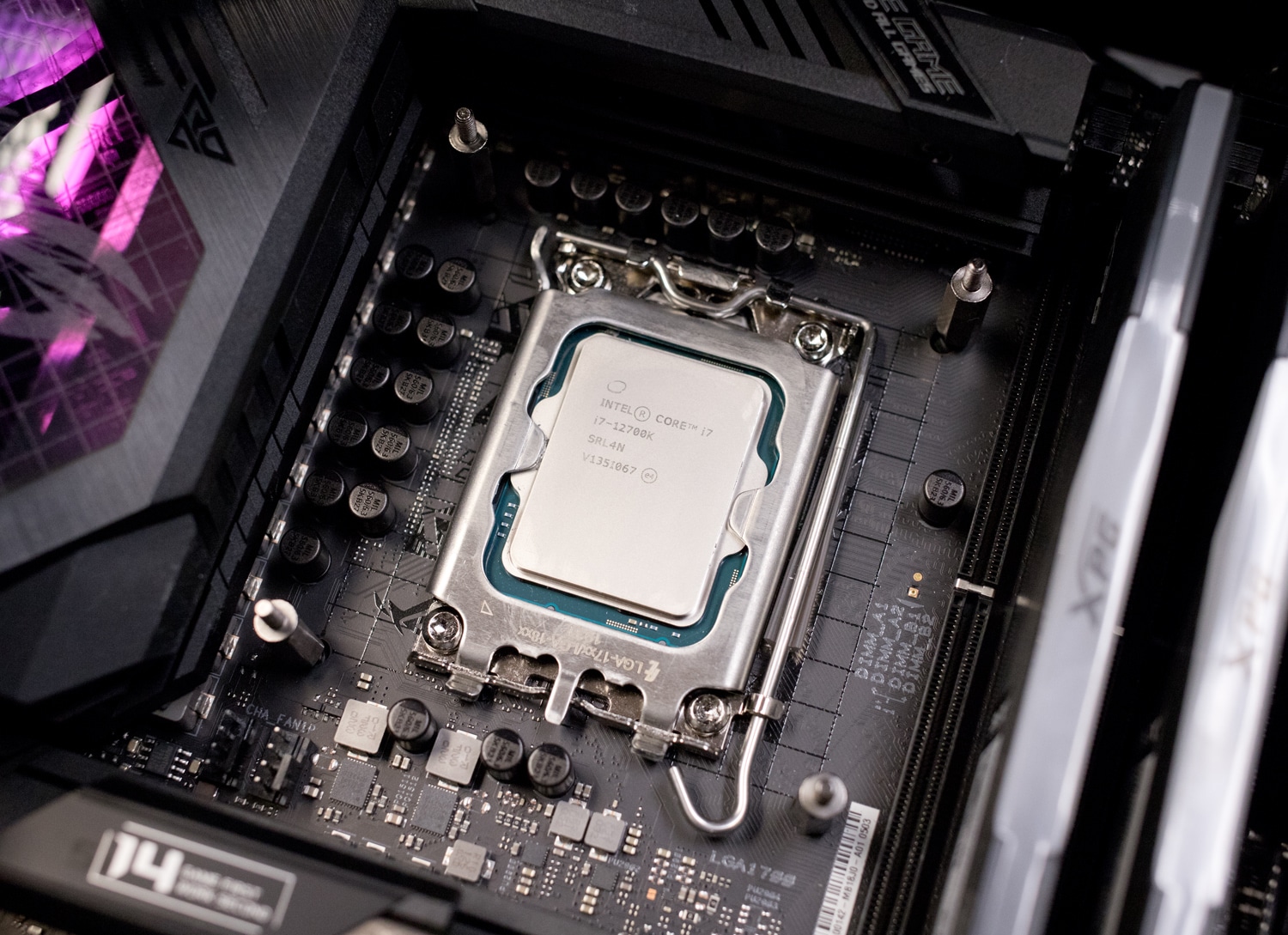
The CPU for this review is the Intel Core i7-12700K. We have reviewed the Core i5-12600K and the Core i9-12900K and with the components from XPG, we wanted to build a system with the processor between the i5 and i9. The i7-12700K was a default pick for us as it is the last one in the lineup for the Alder Lake portfolio and offers a performance boost from the Core i5. The i7-12700K is a 12-core 20-thread processor, configured with 8 performance cores and 4 efficiency cores.
For those that aren’t entirely familiar with the newer generation of Intel CPUs, Intel’s 12th Gen processors, known as Alder Lake features a new standard of chip layout and design. Intel has engineered Performance (P) cores and Efficiency (E) cores, performance cores are used for performance-intensive tasks, like processes in the foreground or hard-hitting programs, while efficiency cores are for less-intensive tasks such as processes that are running in the background. On the downside, however, not all Alder Lake chips have E-cores, chips like the Intel Core i5-12400 only feature P-cores.
Intel’s Thread Director makes the difference between performance and efficiency cores, however, this technology isn’t supported on all operating systems and is only being supported on Windows 11 right now. This means that Windows 10 will see the difference, however, it will still operate as all cores are the same. The same can be said about Linux and other non-Windows 11 builds, this limited OS support is one of the biggest downsides to the Alder Lake portfolio.
Along with the Intel Core i7-12700K processor is the little letter at the end, the K, which means that this i7 is designed to allow users to overclock. The base clock for the efficiency cores is 2.7GHz and for performance cores, it is 3.6GHz, however, with the help of Intel’s Turbo Boost Technology, efficiency cores can reach 3.8GHz, and performance cores can reach 4.9GHz. Also to note for those that overclock, the base processor power is 125W, with a max of 190W.
With the Alder Lake name comes other features besides the new hybrid layout of the chipset, such as support for the all-new DDR5 memory. For the testing of this review, we were able to get a DDR5 memory kit, however, DDR4 memory works just fine for those that are looking for a more cost-effective solution for a gaming/workstation rig. There is even some high-end DDR4 that perform better than the low-end DDR5 kits, however, with the support of ECC memory and decent support speed, DDR5 might be the way to go with the i7-12700K.
The Core i7-12700K integrated graphics, Intel UHD Graphics 770, aren’t the worst thing in the world for basic operation and may work for some. However, if you are getting this processor, there is a good assumption that it is for a mid to high-tier so since it will be paired with a graphics card, you shouldn’t have to worry about integrated graphics. The lower-end chips in the 12th gen line-up are lacking in the integrated area, so pairing them with a GPU is a must.
Overall, the Core i7-12700K is a solid performance processor for those looking for a higher-end machine similar to the i5-12600K. With its performance being right above the i5-12600K, but not nearly as powerful as the i9-12900K, it makes sense that it is priced right now on Amazon at $369.99. The i7-12700K offers a variety of versatility for users looking into the Alder Lake name and hybrid layout.
Intel Core i7-12700K Specifications
| Lithography | Intel 7 |
| CPU Specifications | |
| Total Cores | 12 |
| # of Performance-cores | 8 |
| # of Efficient-cores | 4 |
| Total Threads | 20 |
| Max Turbo Frequency | 5.0GHz |
| Performance-core Max Turbo Frequency | 4.9GHz |
| Efficient-core Max Turbo Frequency | 3.8GHz |
| Performance-core Base Frequency | 3.6GHz |
| Efficient-core Base Frequency | 2.7GHz |
| Cache | 25 MB Intel® Smart Cache |
| Total L2 Cache | 12MB |
| Processor Base Power | 125W |
| Maximum Turbo Power | 190W |
| Memory Specifications | |
| Max Memory Size | 128GB |
| Memory Types |
|
| Max # of Memory Channels | 2 |
| Max Memory Bandwidth | 76.8GB/s |
| ECC Memory Supported | Yes |
| Processor Graphics | |
| Processor Graphics | Intel® UHD Graphics 770 |
| Graphics Base Frequency | 300MHz |
| Graphics Max Dynamic Frequency | 1.5GHz |
| Execution Units | 32 |
| DirectX Support | 12 |
| OpenGL Support | 4.5 |
| # of Displays Supported | 4 |
| OpenCL Support | 2.1 |
| Expansion Options | |
| Direct Media Interface (DMI) Revision | 4.0 |
| Max # of DMI Lanes | 8 |
| PCI Express Revision | 5.0 and 4.0 |
| PCI Express Configurations | Up to 1×16+4, 2×8+4 |
| Max # of PCI Express Lanes | 20 |
| Package Specifications | |
| Sockets Supported | FCLGA1700 |
| Max CPU Configuration | 1 |
| T-junction | 100°C |
| Package Size | 45.0 mm x 37.5 mm |
| Advanced Technologies |
|
| Security and Reliability |
|
XPG Build Framework
The board we’re using is an Asus ROG Strix Z690-E Gaming WiFi, a solid middle ground between Asus’s entry-level Prime and TUF boards and the pricier ROG Maximus and ROG Crosshair lines. Our board has 18+1 power stages and dedicated VRM cooling. It also has an M.2 PCIe 5.0 slot for whenever supporting drives come to market.
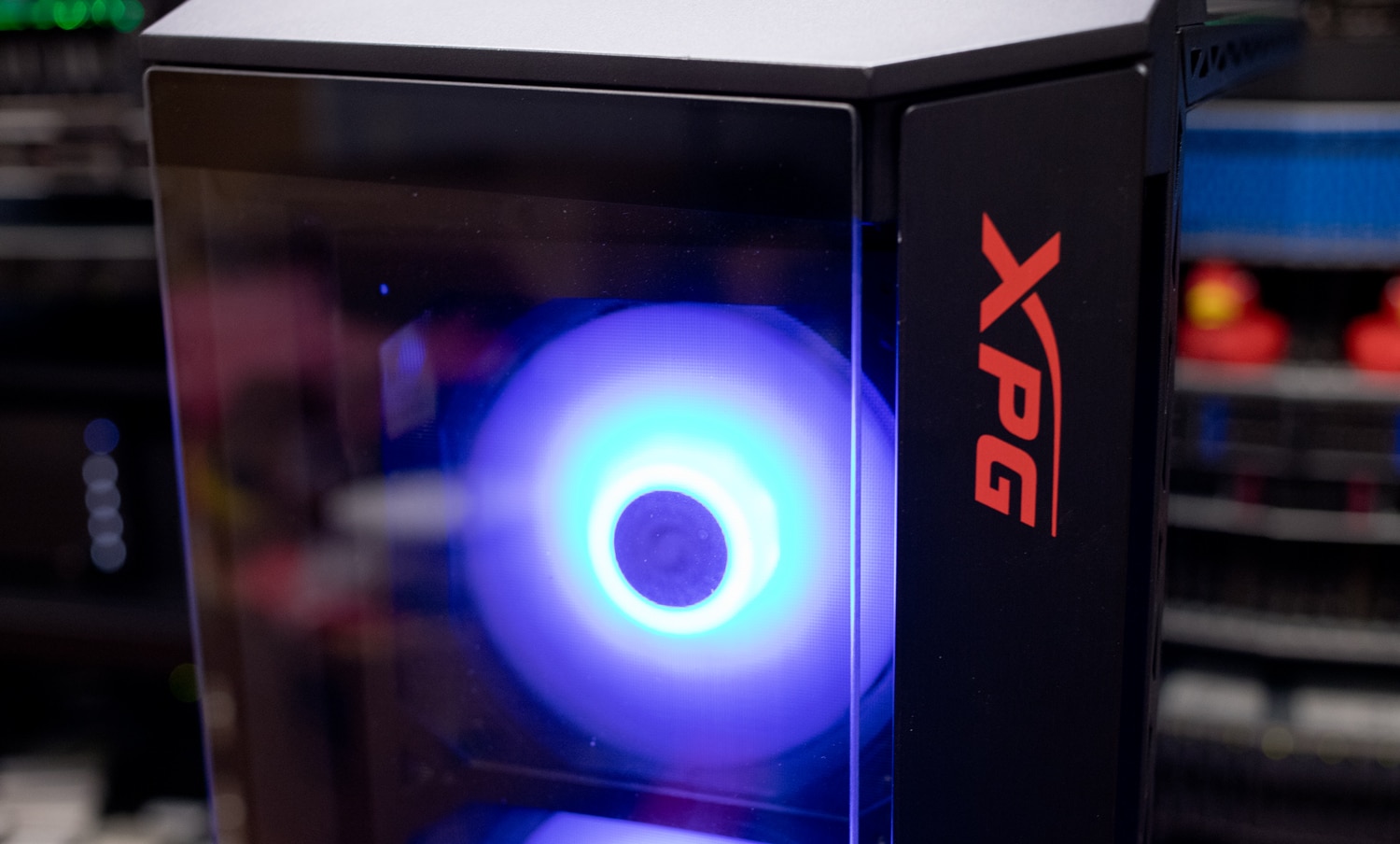
The ROG Strix Z690-E comes with a ton of connectivity options including, an HDMI port, a DisplayPort, four USB 2.0 ports, four USB 3.2 Gen1 ports, three USB 3.2 Gen2 ports (two Type-A and one Type-C), a 2.5Gb Ethernet port, and more. Built with versatility in mind, the Z690 is compatible with a wide range of current and past components, such as cases, PSUs, coolers, and memory kits. Lastly, the Z690 comes with Intel WiFi 6E, the latest WiFi technology and if WiFi isn’t your thing, the Z690 is configured with an Intel 2.5 GbE port.
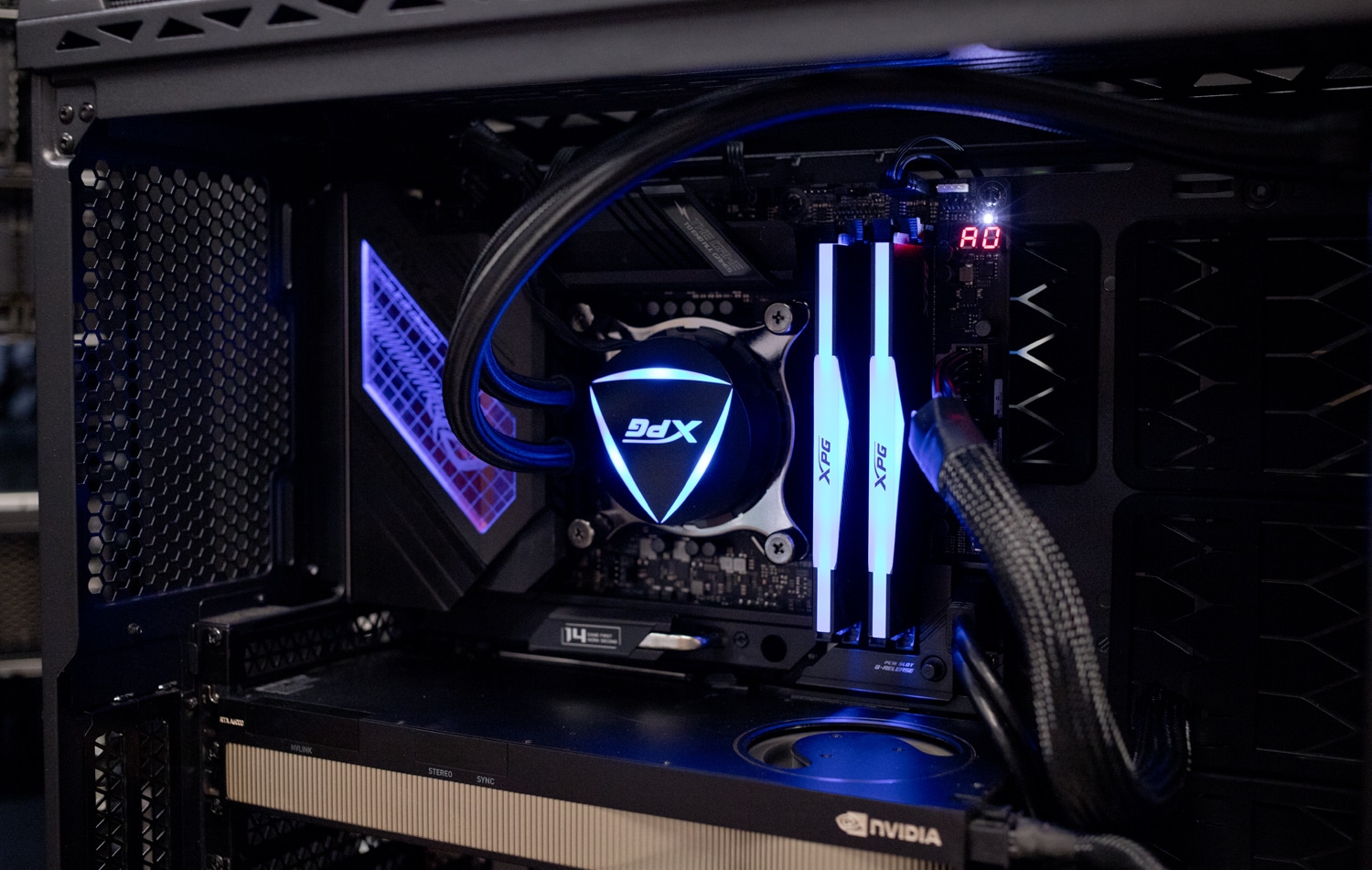
The memory kit that we are going with is the XPG Lancer RGB DDR5-5200. You can check out our full review but for a quick recap, the Lancer DDR5-5200 is the fastest DDR5 that we have tested. The Lancer DDR5 outperformed its competitors, and even though we don’t recommend it for people trying to save money until the prices reflect the DDR4 market, the Lancer DDR5 is still a really good kit especially paired with higher-end Intel and AMD CPUs.
To cool the CPU, we are using the XPG Levante 360. The Levante includes three 3 Vibrant Dual-Ring 120mm ARGB Fans and features an all-aluminum build to help with maximum heat dissipation. The big reason that the Levante 360 is part of this XPG build is that it supports the new LGA 1700 socket which is necessary for the new Intel CPUs. The pump and cold plate utilize Asetek’s new cooling technology to ensure CPU temps are efficiently managed since Intel CPUs do tend to get warm.
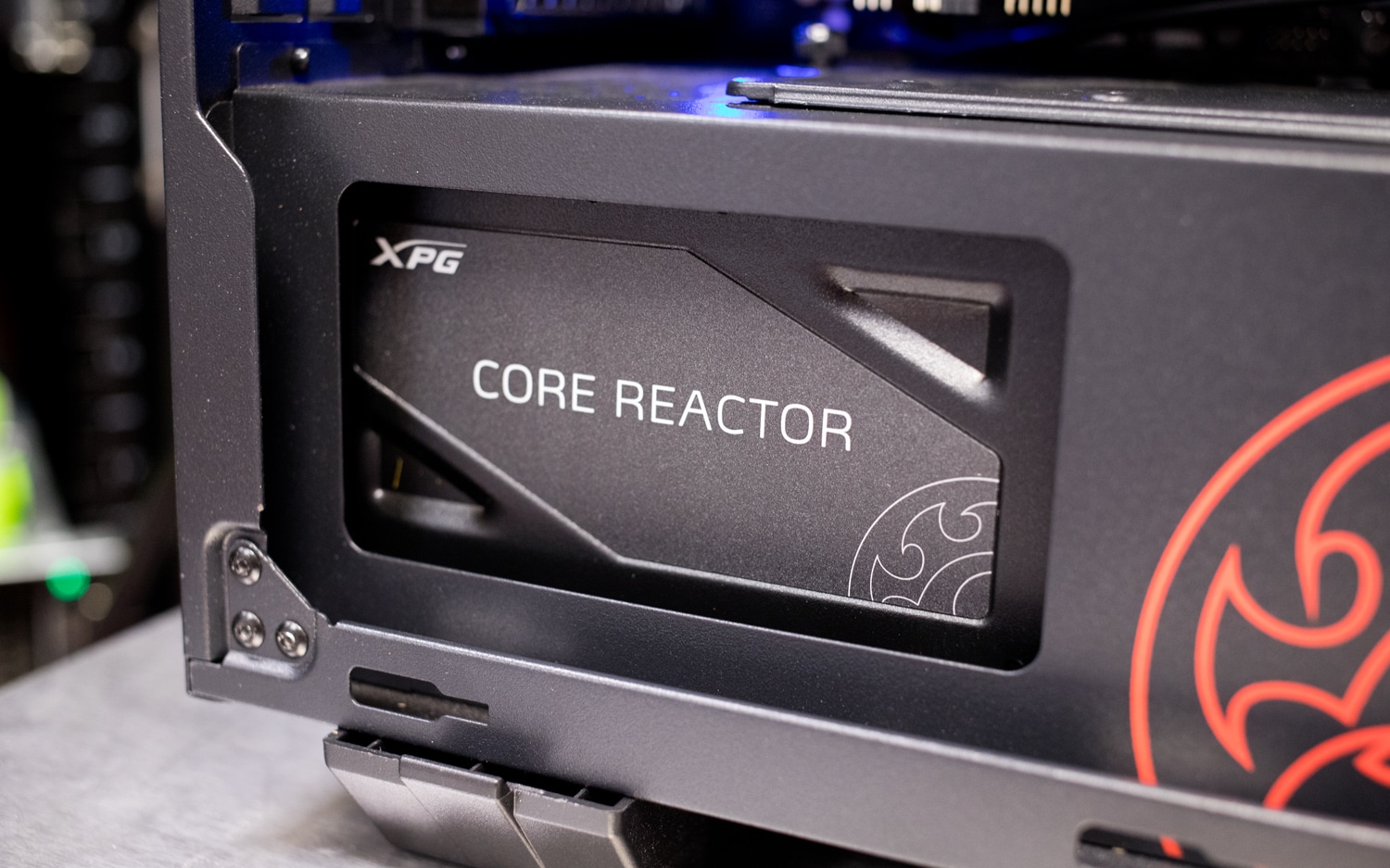
Powering our XPG build is the XPG Core Reactor 750W 80 Plus Gold certified. The Core Reactor features a compact modular design for any cabling needs or if it needs to fit into a compact area. The Core Reactor is also quite quiet, as it leverages XPG’s intelligent fan-curve starting at 660rpm and doesn’t increase until 50% load is recognized. Lastly, it also has a 10-year warranty that covers nearly all possible failures that this PSU could have.
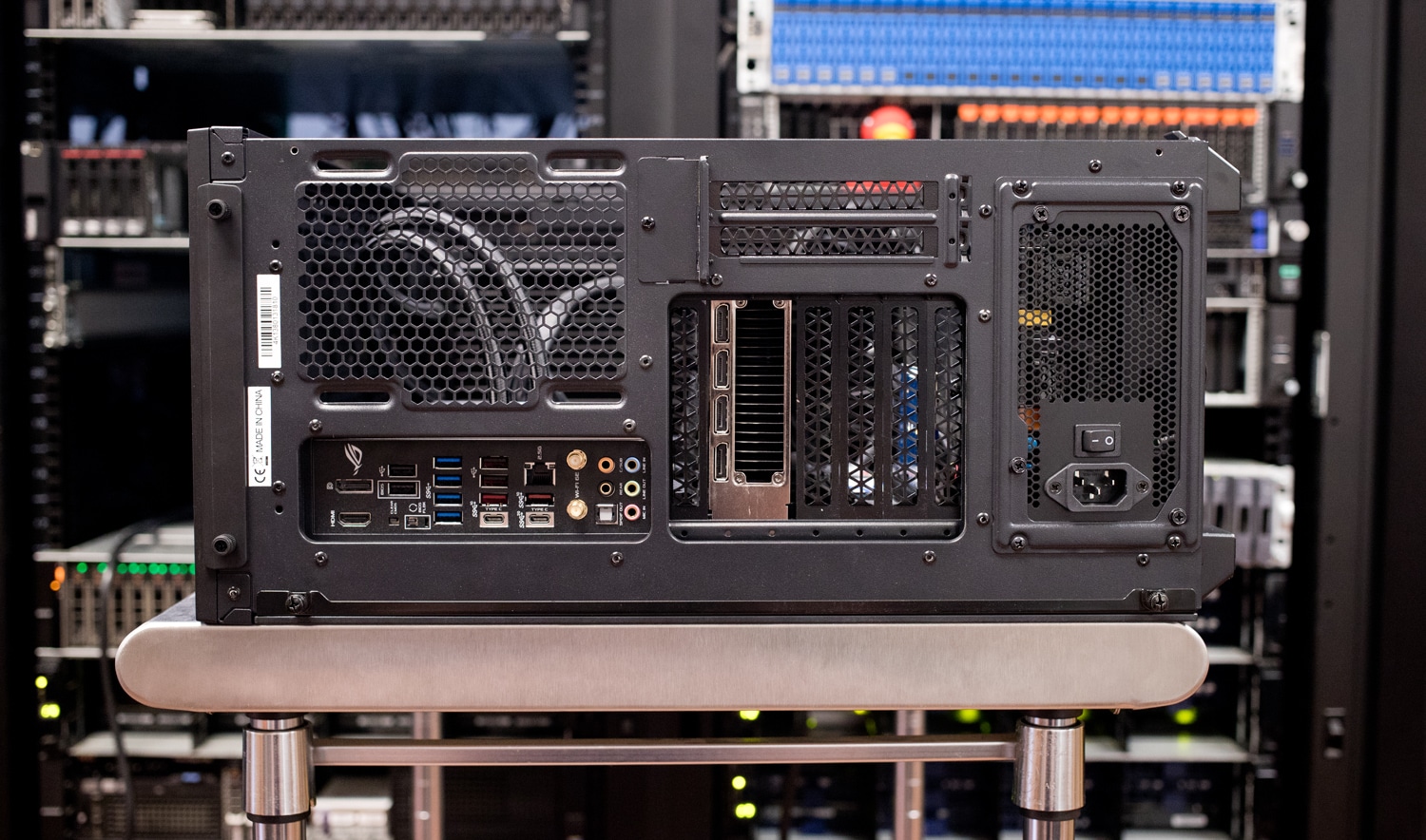
For the GPU, we decided to use an A6000. We wanted some variation within the system to help showcase the various functions and uses that the TUF build can handle. We initially went with the A6000 to show the workstation capabilities of this build and also because some systems get agitated if there isn’t a GPU within the system. With the A6000 as well, it shows users that the highest RTX cards aren’t necessary to get decent performance from a system.
The case that XPG has sent us is the XPG BATTLECRUISER Super Mid-Tower PC Chassis. This case is on the larger end for Mid-Tower Chasis which offers a wide range of versatility for most PC components. The BattleCruiser sports an all-metal design with glass panes to show off the internals and RGB support. The Battlecruiser also features a modular tool-less design making it easier to build on as well. On a final note, the Battlecruiser top I/O shows off a Type-C port, two Type-A ports, headphone/audio, and more, as well as a unique power button shaped like a play button.
Intel Core-i7 + XPG Performance
Now for testing. Pur rig has the following basic hardware:
- Intel Core i7-12700K CPU
- ASUS ROG Strix Z690-E
- Microsoft Windows 11
- XPG Lancer RGB DDR5-5200
- TEAMGROUP T-FORCE Cardea Z440 NVMe M.2 SSD
- Nvidia RTX A6000
We’re using our Intel Core i9-12900K Alder Lake workstation and the Intel Core i5-12600K Alder Lake workstation for comparisons and we believe that this provides the best comparison as it is a good way to look at each Alder Lake iteration.
SPECviewperf 2020
SPECviewperf 2020 is the worldwide standard for measuring the graphics performance of professional applications under the OpenGL and Direct X application programming interfaces. The view sets (or benchmarks) represent graphics content and behavior from actual applications, without having to install the applications themselves. The newest version of this benchmark went through major updates late last year, including new view sets taken from traces of the latest versions of 3ds Max, Catia, Maya, and Solidworks applications. In addition, they added support within all view sets for both 2K and 4K resolution displays. Our tests were run with a windowed resolution of 3800×1200.
| SPECviewperf 2020 (Higher is better) | |||
| Viewsets | StorageReview Test Rig (Core i7-12700K, RTX A6000) | StorageReview Test Rig (Core i5-12600K, RTX A4000) | StorageReview Test Rig (Core i9-12900K, RTX A6000) |
| 3dsmax-07 | 137.99 | 93.02 | 138.71 |
| Catia-06 | 100.77 | 70.92 | 99.21 |
| Creo-03 | 155.75 | 119.18 | 154.25 |
| Energy-03 | 42.74 | 21.78 | 42.89 |
| Maya-06 | 339.75 | 229.65 | 334.1 |
| Medical-03 | 34.6 | 20.34 | 34.92 |
| Snx-04 | 443.45 | 328.98 | 446.73 |
| Sw-05 | 165.41 | 108.18 | 166.42 |
SPECworkstation 3
Moving on with our performance benchmarks, we ran SPECworkstation3. This is a test that specializes in benchmarks designed for testing all key aspects of workstation performance; it uses over 30 workloads to test CPU, graphics, I/O, and memory bandwidth. The workloads fall into broader categories such as Media and Entertainment, Financial Services, Product Development, Energy, Life Sciences, and General Operations. We are going to list the broad-category results for each, as opposed to the individual workloads. The results are an average of all the individual workloads in each category.
| SPECworkstation 3 (Higher is better) | |||
| Category | StorageReview Test Rig (Core i7-12700K, RTX A6000) | StorageReview Test Rig (Core i5-12600K, RTX A4000) | StorageReview Test Rig (Core i9-12900K, RTX A6000) |
| M&E | DNF | DNF | DNF |
| ProdDev | 4.98 | 4.19 | DNF |
| LifeSci | 4.79 | 3.66 | 5.19 |
| Energy | 5.39 | 3.95 | 6.34 |
| FSI | 3.78 | 3.52 | 5.54 |
| GeneralOps | 3.32 | 2.76 | 3.14 |
| GPU Compute | DNF | 5.44 | 7.76 |
Blender
Next up is Blender, an open-source 3D modeling application. This benchmark was run using the Blender Benchmark utility. The score is samples per minute, with higher being better.
| Blender, rendering samples per minute (higher is better) | |||
| Category | StorageReview Test Rig (Core i7-12700K, RTX A6000) | StorageReview Test Rig (Core i5-12600K, RTX A4000) | StorageReview Test Rig (Core i9-12900K, RTX A6000) |
| Monster | 2,770 | 1,647 | 2,774 |
| Junkshop | 1,551 | 941 | 1,552 |
| Classroom | 1,370 | 856 | 1,364 |
Esri
Next up is the Environmental Systems Research Institute (Esri) benchmark. Esri is a supplier of Geographic Information System (GIS) software. Esri’s Performance Team designed their PerfTool add-in scripts to automatically launch the ArcGIS Pro. This application uses a “ZoomToBookmarks” function to browse various predefined bookmarks and create a log file with all the key data points required to predict the user experience. The script automatically loops the bookmarks three times to account for caching (memory and disk cache). In other words, this benchmark simulates heavy graphical use that one might see through Esri’s ArcGIS Pro software.
| ESRI ArcGIS Pro 2.3 Montreal | |
| Average FPS | Average |
| StorageReview Test Rig (Core i7-12700K, RTX A6000) | 597.59 |
| StorageReview Test Rig (Core i5-12600K, RTX A4000) | 348.72 |
| StorageReview Test Rig (Core i9-12900K, RTX A6000) | 607.29 |
| Minimum FPS | Average |
| StorageReview Test Rig (Core i7-12700K, RTX A6000) | 313.74 |
| StorageReview Test Rig (Core i5-12600K, RTX A4000) | 174.48 |
| StorageReview Test Rig (Core i9-12900K, RTX A6000) | 324.74 |
Next is the Philly model where our XPG build was quite a middleman compared to other builds.
| ESRI ArcGIS Pro 2.3 Philly | |
| Average FPS | Average |
| StorageReview Test Rig (Core i7-12700K, RTX A6000) | 460.15 |
| StorageReview Test Rig (Core i5-12600K, RTX A4000) | 247.88 |
| StorageReview Test Rig (Core i9-12900K, RTX A6000) | 473.49 |
| Minimum FPS | Average |
| StorageReview Test Rig (Core i7-12700K, RTX A6000) | 277.96 |
| StorageReview Test Rig (Core i5-12600K, RTX A4000) | 152.38 |
| StorageReview Test Rig (Core i9-12900K, RTX A6000) | 273.93 |
The story remains the same in our last animation, Portland.
| ESRI ArcGIS Pro 2.3 Portland | |
| Average FPS | Average |
| StorageReview Test Rig (Core i7-12700K, RTX A6000) | 3,210.99 |
| StorageReview Test Rig (Core i5-12600K, RTX A4000) | 2,449.52 |
| StorageReview Test Rig (Core i9-12900K, RTX A6000) | 2,980.10 |
| Minimum FPS | Average |
| StorageReview Test Rig (Core i7-12700K, RTX A6000) | 1,453.46 |
| StorageReview Test Rig (Core i5-12600K, RTX A4000) | 984.73 |
| StorageReview Test Rig (Core i9-12900K, RTX A6000) | 1,360.30 |
Luxmark
Another 3D benchmark we will be looking at is LuxMark, an OpenCL GPU benchmarking utility. This is another test where the CPU isn’t a major factor, the load mostly falling on the GPU.
| LuxMark (Higher is better) | |||
| Category | StorageReview Test Rig (Core i7-12700K, RTX A6000) | StorageReview Test Rig (Core i5-12600K, RTX A4000) | StorageReview Test Rig (Core i9-12900K, RTX A6000) |
| hallbench | 22,380 | 12,666 | 21,365 |
| food | 8,515 | 4,920 | 8,088 |
OctaneBench
Last, we look OctaneBench, a benchmarking utility for OctaneRender, which is another 3D renderer with RTX support that is similar to V-Ray. Higher scores are better. Like Luxmark, OctaneBench is large GPU-dependent, so the differences are slight between our rig and the workstation.
| Scene | Kernel | StorageReview Test Rig (Core i7-12700K, RTX A6000) | StorageReview Test Rig (Core i5-12600K, RTX A4000) | StorageReview Test Rig (Core i9-12900K, RTX A6000) |
| Interior | Info channels | 18.44 | 11.48 | 18.53 |
| Interior | Direct lighting | 66.66 | 39.84 | 67.25 |
| Interior | Path tracing | 86.89 | 50.97 | 87.28 |
| Idea | Info channels | 11.60 | 7.10 | 11.52 |
| Idea | Direct lighting | 52.67 | 31.10 | 52.74 |
| Idea | Path tracing | 64.99 | 38.20 | 65.34 |
| ATV | Info channels | 29.27 | 17.66 | 29.15 |
| ATV | Direct lighting | 75.30 | 44.01 | 74.84 |
| ATV | Path tracing | 94.28 | 55.13 | 94.82 |
| Box | Info channels | 15.86 | 9.73 | 15.90 |
| Box | Direct lighting | 67.20 | 39.46 | 66.80 |
| Box | Path tracing | 75.51 | 44.34 | 75.93 |
Conclusion
Our XPG build will notably be a use case for anything and everything. With a configuration of an Intel Core i7-12700K, 32GB of RAM, and an NVIDIA RTX A6000, this XPG-based build will be able to perform well as a mid-to-high range workstation by day, gaming at night, system. Our XPG build would perform great as a sole workstation for those that want to take a different route than gaming, with the configuration we have, this build would work as an edition station, a high-end business machine, and much more.
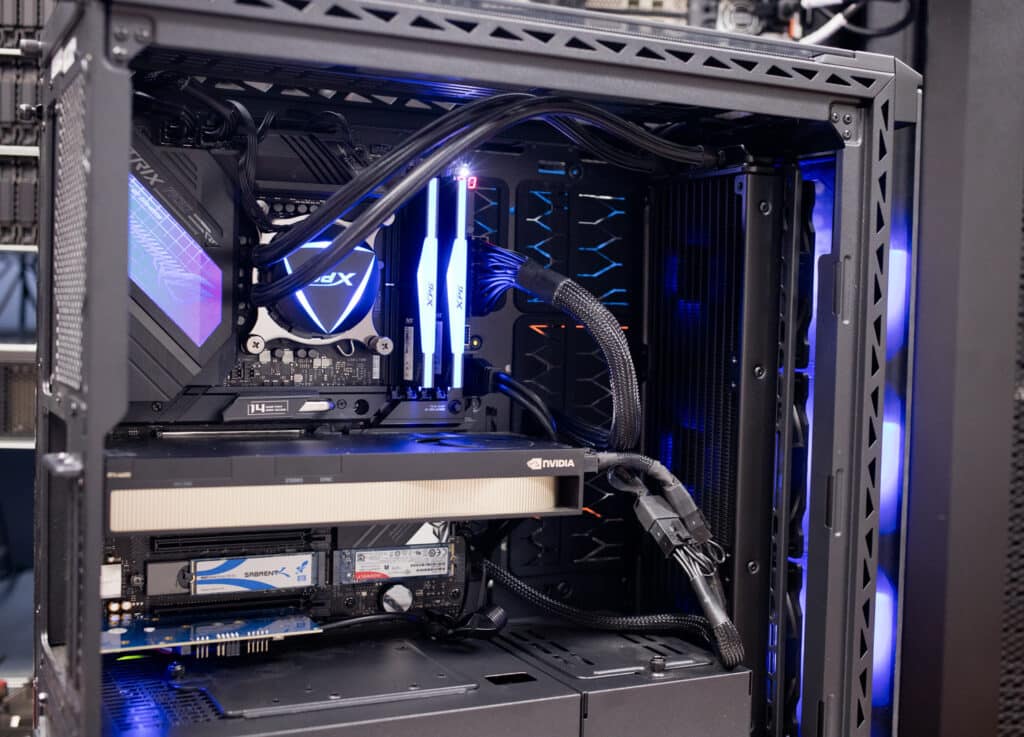
One point that we did want to make was the adoption costs of this system. What we mean by this is in reference to DDR5 memory and motherboard compatibility. Whenever someone wants to upgrade their system, there is usually a hole that they fall into; if they want to upgrade the CPU, then a new motherboard is necessary and with a new motherboard, is a newer kit of memory required? Things like this all come into account when thinking about a new system, and with XPG and the constant new products and innovations, some of these costs will be alleviated. The newer motherboards, support DDR5 and DDR4 and because of this, those that want to upgrade in the future will have an easier time since they won’t have to upgrade multiple components at the same time.
In terms of performance, the Intel Core i7-12700K CPU and A6000 performed quite well compared to the i5 and the i9. In some of the tests we actually saw that the i7 build performed better than the i9 build, not by much, but it did. This build included the XPG Lancer RGB DDR5-5200 RAM which was the fastest in that group we tested. There was an assumption that it would fall more or less in between the i5 and i9 build, however, with the A6000, the i7 build had an optimal performance. This particular build does show what a mid-high tier CPU can do with an A6000, however even if it had the A4000, we would have seen decent performance still.




 Amazon
Amazon